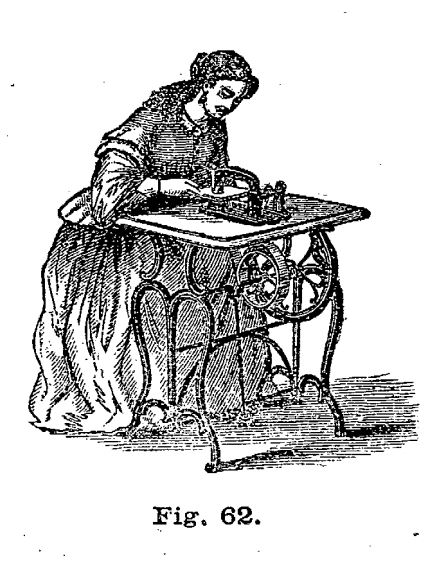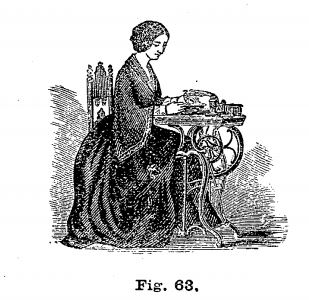We know of no better rule in sitting than the simple one, “sit gracefully.” A graceful position is a natural one, and will be productive neither of inconvenience nor injury.
The distortions of the spine produced by improper positions in sitting are only in part due to the changes produced in the cartilages of the spinal column. At the same time that changes in the cartilage discs are being made, changes are also taking place in the numerous muscles of the spine. When the body is bent out of its proper shape, while certain muscles are contracted, others are stretched beyond their natural length. If the tension is maintained but a short period, the natural elasticity of the muscle restores it to its natural length again, and so brings the body into proper position; but if it be prolonged, the tonicity of the muscular fibers is in some degree lost. They give up their elasticity and become abnormally lengthened without power to return fully to their natural position. At the same time, the muscles which are contracted while the curved position is maintained, become by the exercise stronger than their antagonizing muscles, which are at the same time being weakened by want of use and abnormal stretching. Thus the evil results are doubled, and the curvature which was at first a mere temporary evil becomes permanently fixed in the body by unequal muscular contraction.




Figs. 59, 60, 61, 62, and 64, show positions which are very commonly assumed by students and others. The figures explain themselves at a glance. Many other bad positions are common, not a few of which are undoubtedly due to the improper construction of chairs, sofas, school seats, and desks. In. many instances in schools, large students are placed in seats which are too low for them (see Fig. 60), and which require or at least strongly incline them to lean forward while engaged in their studies, making them round-shouldered and narrow-chested.

It is probable, however, that the opposite error is much more common, and is certainly much more injurious, viz., placing small students in seats which are too large and too high for them. When this is dope, several evils result. The feet not being properly supported, the weight of the limbs constantly drags upon the spine, and requires that its muscles be kept constantly in contraction, and at a disadvantage. The desk being too high, in writing the arm must be lifted so high as to unavoidably produce curvature of the spine by elevation of the shoulder. Other evils are also almost certain to follow, among which are disturbances of vision from holding the book too near the eyes, disturbance of the circulation, especially in the lower extremities, due to unnatural pressure on the underside of the limbs, and nervous affections from the unnatural strain upon the sensitive spine from the want of support to the limbs.
Another evil very common in the construction of seats for schoolchildren is placing the desk too far away from the seat (see Fig. 64), thus not only inviting but actually obliging the pupil to lean forward in writing, drawing, or ciphering. This evil is of no small consequence, and we are glad to see that it is being remedied by some manufacturers. Still another common failure is neglect to so shape the backs of seats as to enable them to support the spine at its weakest point. This latter evil is probably as great a cause of curvature as any. The spine becomes tired from want of proper support, and the pupil leans over to get relief.

It is possible to obtain chairs which are reasonably correct in construction. The principal points which need to be looked at are the following:—
- A chair should be so constructed that it will properly support the back, not by one or two slats placed crosswise; but by a uniform curve, corresponding as nearly as possible with the natural curve of the spine. The whole spine should be supported without requiring a person to throw the shoulders forward in order to bring the lower or middle part of the spine in contact with the back of the chair.
- It is also important that chairs should be of proper height, so that the weight of the limbs may be supported by the feet set squarely upon the floor instead of hanging upon the front edge of the chair. Nearly all chairs are made too high, if not for the adult persons in the family, for nearly all the younger members, who most of all need seats properly constructed. There should be chairs of different heights for – different members of the family; and the importance of the matter is sufficient to justify the incurment of the expense necessary to secure each member of the family against injury from this cause.
While we are by no means inclined to be ultra upon the subject, we must enter a word of protest against the too common use of rocking chairs. As usually constructed, they induce an improper attitude in the occupant, one which limits the action of the lungs and produces roundness of the shoulders. We seldom sit in a rocking-chair for a half-hour without finding it necessary to get up and walk about, expanding the chest and filling the lungs to relieve the feeling of oppression which results from the confinement of the chest. We have frequently observed in patients suffering with lung troubles a careful avoidance of rocking chairs, and upon making inquiry have found that what we say is true. They avoided the rocking-chair because with their diminished lung capacity they could not breathe well while sitting in it.
While the rocking-chair is undoubtedly a comfort to thousands, we have no doubt that on the whole it has been a curse to the race, especially to womankind. We may have easy chairs, made as soft and luxurious as possible; but let them be made in accordance with physiological principles. Art has made the models for chairs rather than nature. If we would follow art less and nature more in numerous ways we should be vastly better off.
A lightly edited reprint of a piece from The Home Handbook of Domestic Hygiene and Rational Medicine by Dr. John Harvey Kellogg.